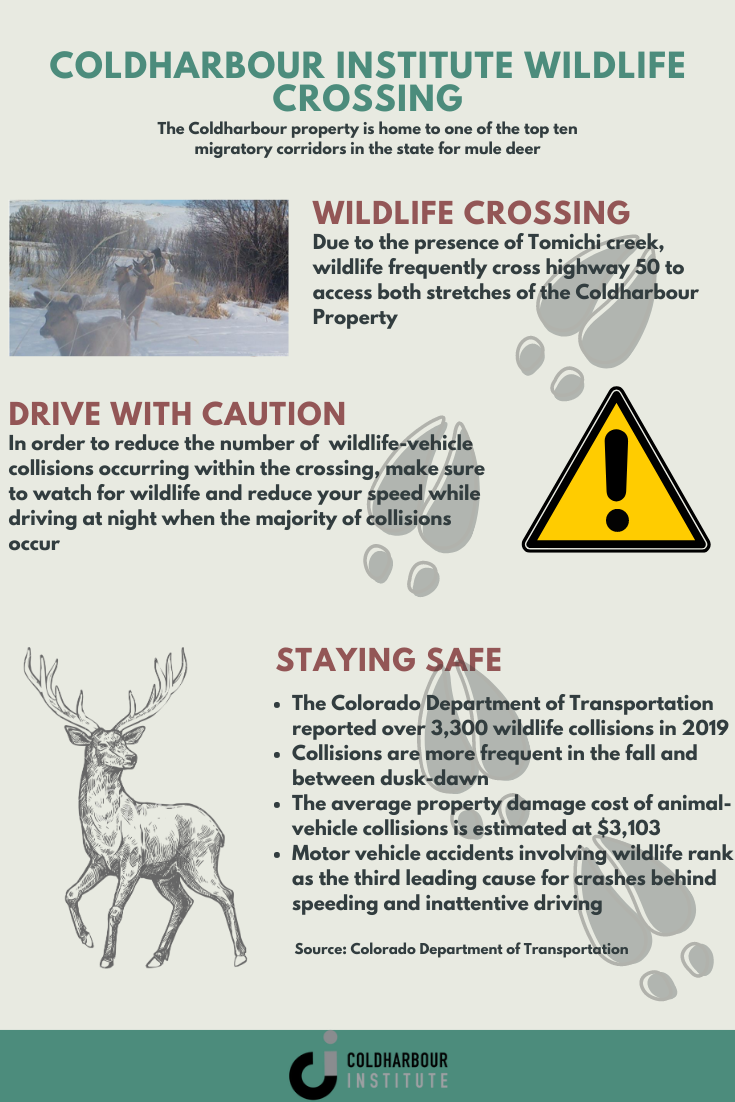|
In 2019, Ashley Merkel, a Masters of Environmental Management alumni from Western Colorado University conducted a project to create a Wildlife Management Plan for the Coldharbour Ranch. In doing so, she discovered and defined one of the top ten wildlife corridors for mule deer in the state of Colorado. Coldharbour Ranch happens to lie within a migration route that ungulates travel along in order to reach summer and winter ranges in the Gunnison Basin. This migration route crosses Highway 50, along a north-south axis. Out of 334 total acres, 243 of those acres constituting Coldharbour are under a conservation easement. No development or livestock ranching is permitted on the land protected by the easement. This allows for wildlife to roam uninhibited on the land without competition from cattle and the presence of Tomichi Creek on the Coldharbour property provides the much needed resource of water. The conservation easement has most likely created a safe haven for wildlife especially in an area that has become developed and most open ranges are being used to ranch cattle. The migration corridor is just now being studied and looked at but has probably been used by wildlife long before Gunnison was founded and settled. The only difference is that now the corridor crosses a major highway. Over the years, wildlife-vehicle collisions have increased along this stretch of highway (Pankratz 2016, Webb 2019). These collisions happen more often in the winter when snow banks from plowing the roads create obstacles and slow down ungulates from crossing the highway (Webb 2019). There is a lack of signage where this corridor is located informing drivers to be extra alert for potential mule deer crossings. Wildlife-vehicle collisions are concerns along any roadway and safe wildlife corridors are an effective solution to reduce the number of collisions. Wildlife corridors such as overpasses and underpasses have been used for decades in European countries. The use of wildlife corridors is becoming increasingly prevalent in southern US states such as Wyoming, Nevada and Oregon. Public support of wildlife corridors in New Mexico and Colorado is 85% according to a recent poll from the National Wildlife Federation. In August of 2019, Colorado Governor Jared Polis signed an executive order directing state agencies to identify and protect wildlife corridors. With recorded mule deer crossing Highway 50 and connected roadside casualties there is a recognized need from Coldharbour to protect this corridor. The executive order from Governor Polis includes direction to the Colorado Department of Transportation to enable safe wildlife passage and efforts to reduce wildlife-vehicle collisions. There are several proven methods that have been utilized to reduce deer-vehicle collisions and raise public awareness of key migratory routes. Introducing signage in advance of crossings has been shown to reduce the number of collisions. This is a simple and effective first step to reducing vehicle-wildlife collisions along Highway 50 before a larger project such as a wildlife overpass can be put into place. It is the goal of Coldharbour Institute to support this wildlife corridor, and work with important community partners such as CDOT and Colorado Parks and Wildlife (CPW) to utilize best practices to establish a more safe wildlife corridor, both for the crossing animals and the people of the Gunnison Valley. Pankratz, H. (2016, May 08). Study: More cars hitting wildlife on highways in Colorado, nationwide. Retrieved September 25, 2020, from https://www.denverpost.com/2008/01/31/study-more-cars-hitting-wildlife-on-highways-in-colorado-nationwide/ Webb, D. (2019, March 21). As deer become more active, drivers urged to be vigilant. Retrieved September 25, 2020, from https://www.gjsentinel.com/news/western_colorado/as-deer-become-more-active-drivers-urged-to-be-vigilant/article_7e798868-4b95-11e9-8850-20677ce06c14.html Written by Anna Markey, Kathryn Bickley, and Lily Richards. Students in the Master of Environmental Management at Western Colorado University.
1 Comment
|
Ongoing ResearchNotes from the field of Coldharbour Ranch. Archives
October 2021
Categories
All
|
Sign up for our newsletter below.
|
|
Coldharbour Institute is a 501(c)3 Non-Profit Organization
P.O. Box 463 Gunnison CO 81230 |

 RSS Feed
RSS Feed
